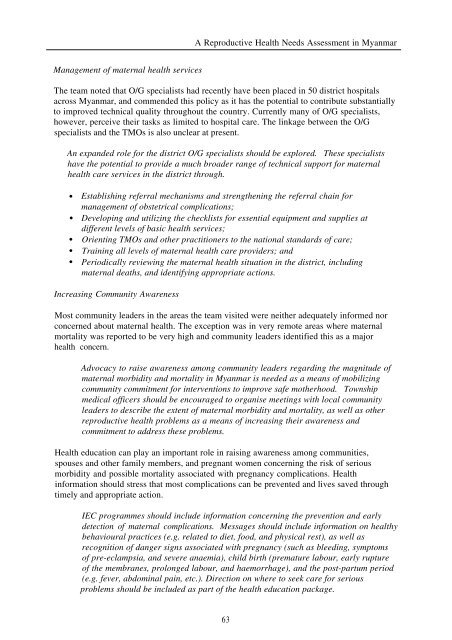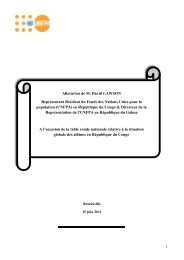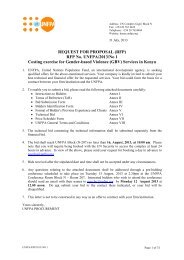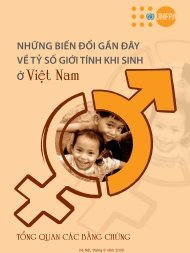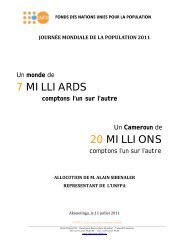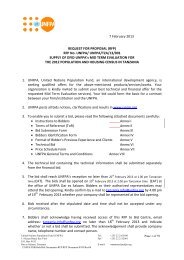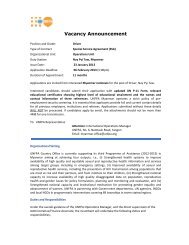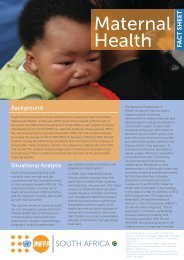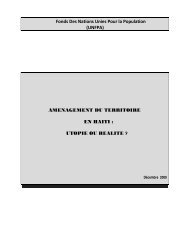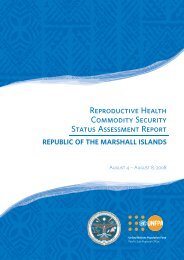A reproductive health needs assessment in Myanmar
A reproductive health needs assessment in Myanmar
A reproductive health needs assessment in Myanmar
You also want an ePaper? Increase the reach of your titles
YUMPU automatically turns print PDFs into web optimized ePapers that Google loves.
A Reproductive Health Needs Assessment <strong>in</strong> <strong>Myanmar</strong><br />
Management of maternal <strong>health</strong> services<br />
The team noted that O/G specialists had recently have been placed <strong>in</strong> 50 district hospitals<br />
across <strong>Myanmar</strong>, and commended this policy as it has the potential to contribute substantially<br />
to improved technical quality throughout the country. Currently many of O/G specialists,<br />
however, perceive their tasks as limited to hospital care. The l<strong>in</strong>kage between the O/G<br />
specialists and the TMOs is also unclear at present.<br />
An expanded role for the district O/G specialists should be explored. These specialists<br />
have the potential to provide a much broader range of technical support for maternal<br />
<strong>health</strong> care services <strong>in</strong> the district through.<br />
• Establish<strong>in</strong>g referral mechanisms and strengthen<strong>in</strong>g the referral cha<strong>in</strong> for<br />
management of obstetrical complications;<br />
• Develop<strong>in</strong>g and utiliz<strong>in</strong>g the checklists for essential equipment and supplies at<br />
different levels of basic <strong>health</strong> services;<br />
• Orient<strong>in</strong>g TMOs and other practitioners to the national standards of care;<br />
• Tra<strong>in</strong><strong>in</strong>g all levels of maternal <strong>health</strong> care providers; and<br />
• Periodically review<strong>in</strong>g the maternal <strong>health</strong> situation <strong>in</strong> the district, <strong>in</strong>clud<strong>in</strong>g<br />
maternal deaths, and identify<strong>in</strong>g appropriate actions.<br />
Increas<strong>in</strong>g Community Awareness<br />
Most community leaders <strong>in</strong> the areas the team visited were neither adequately <strong>in</strong>formed nor<br />
concerned about maternal <strong>health</strong>. The exception was <strong>in</strong> very remote areas where maternal<br />
mortality was reported to be very high and community leaders identified this as a major<br />
<strong>health</strong> concern.<br />
Advocacy to raise awareness among community leaders regard<strong>in</strong>g the magnitude of<br />
maternal morbidity and mortality <strong>in</strong> <strong>Myanmar</strong> is needed as a means of mobiliz<strong>in</strong>g<br />
community commitment for <strong>in</strong>terventions to improve safe motherhood. Township<br />
medical officers should be encouraged to organise meet<strong>in</strong>gs with local community<br />
leaders to describe the extent of maternal morbidity and mortality, as well as other<br />
<strong>reproductive</strong> <strong>health</strong> problems as a means of <strong>in</strong>creas<strong>in</strong>g their awareness and<br />
commitment to address these problems.<br />
Health education can play an important role <strong>in</strong> rais<strong>in</strong>g awareness among communities,<br />
spouses and other family members, and pregnant women concern<strong>in</strong>g the risk of serious<br />
morbidity and possible mortality associated with pregnancy complications. Health<br />
<strong>in</strong>formation should stress that most complications can be prevented and lives saved through<br />
timely and appropriate action.<br />
IEC programmes should <strong>in</strong>clude <strong>in</strong>formation concern<strong>in</strong>g the prevention and early<br />
detection of maternal complications. Messages should <strong>in</strong>clude <strong>in</strong>formation on <strong>health</strong>y<br />
behavioural practices (e.g. related to diet, food, and physical rest), as well as<br />
recognition of danger signs associated with pregnancy (such as bleed<strong>in</strong>g, symptoms<br />
of pre-eclampsia, and severe anaemia), child birth (premature labour, early rupture<br />
of the membranes, prolonged labour, and haemorrhage), and the post-partum period<br />
(e.g. fever, abdom<strong>in</strong>al pa<strong>in</strong>, etc.). Direction on where to seek care for serious<br />
problems should be <strong>in</strong>cluded as part of the <strong>health</strong> education package.<br />
63


